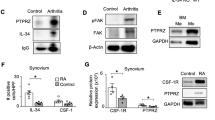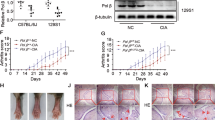Abstract
A20 (TNFAIP3) is a protein that is involved in the negative feedback regulation of NF-κB signaling in response to specific proinflammatory stimuli in different cell types and has been suggested as a susceptibility gene for rheumatoid arthritis. To define the contribution of A20 to rheumatoid arthritis pathology, we generated myeloid-specific A20-deficient mice and show that specific ablation of Tnfaip3 in myeloid cells results in spontaneous development of a severe destructive polyarthritis with many features of rheumatoid arthritis. Myeloid-A20–deficient mice have high levels of inflammatory cytokines in their serum, consistent with a sustained NF-κB activation and higher TNF production by macrophages. Destructive polyarthritis in myeloid A20 knockout mice was TLR4-MyD88 and IL-6 dependent but was TNF independent. Myeloid A20 deficiency also promoted osteoclastogenesis in mice. Together, these observations indicate a critical and cell-specific function for A20 in the etiology of rheumatoid arthritis, supporting the idea of developing A20 modulatory drugs as cell-targeted therapies.
This is a preview of subscription content, access via your institution
Access options
Subscribe to this journal
Receive 12 print issues and online access
$209.00 per year
only $17.42 per issue
Buy this article
- Purchase on Springer Link
- Instant access to full article PDF
Prices may be subject to local taxes which are calculated during checkout




Similar content being viewed by others
References
Coornaert, B., Carpentier, I. & Beyaert, R. A20: central gatekeeper in inflammation and immunity. J. Biol. Chem. 284, 8217–8221 (2009).
Wertz, I.E. et al. De-ubiquitination and ubiquitin ligase domains of A20 downregulate NF-κB signalling. Nature 430, 694–699 (2004).
Boone, D.L. et al. The ubiquitin-modifying enzyme A20 is required for termination of Toll-like receptor responses. Nat. Immunol. 5, 1052–1060 (2004).
Hitotsumatsu, O. et al. The ubiquitin-editing enzyme A20 restricts nucleotide-binding oligomerization domain containing 2-triggered signals. Immunity 28, 381–390 (2008).
Düwel, M. et al. A20 negatively regulates T cell receptor signaling to NF-κB by cleaving Malt1 ubiquitin chains. J. Immunol. 182, 7718–7728 (2009).
Lee, E.G. et al. Failure to regulate TNF-induced NF-κB and cell death responses in A20-deficient mice. Science 289, 2350–2354 (2000).
Vereecke, L., Beyaert, R. & van Loo, G. The ubiquitin-editing enzyme A20 (TNFAIP3) is a central regulator of immunopathology. Trends Immunol. 30, 383–391 (2009).
Vereecke, L. et al. Enterocyte-specific A20 deficiency sensitizes to tumor necrosis factor-induced toxicity and experimental colitis. J. Exp. Med. 207, 1513–1523 (2010).
Clausen, B.E., Burkhardt, C., Reith, W., Renkawitz, R. & Forster, I. Conditional gene targeting in macrophages and granulocytes using LysMcre mice. Transgenic Res. 8, 265–277 (1999).
Turer, E.E. et al. Homeostatic MyD88-dependent signals cause lethal inflamMation in the absence of A20. J. Exp. Med. 205, 451–464 (2008).
Taylor, P.C. & Feldmann, M. Anti-TNF biologic agents: still the therapy of choice for rheumatoid arthritis. Nat. Rev. Rheumatol. 5, 578–582 (2009).
Rothe, J. et al. Mice lacking the tumour necrosis factor receptor 1 are resistant to TNF-mediated toxicity but highly susceptible to infection by Listeria monocytogenes. Nature 364, 798–802 (1993).
Huang, Q.Q. & Pope, R.M. The role of Toll-like receptors in rheumatoid arthritis. Curr. Rheumatol. Rep. 11, 357–364 (2009).
Hennessy, E.J., Parker, A.E. & O'Neill, L.A. Targeting Toll-like receptors: emerging therapeutics? Nat. Rev. Drug Discov. 9, 293–307 (2010).
Adachi, O. et al. Targeted disruption of the MyD88 gene results in loss of IL-1– and IL-18–mediated function. Immunity 9, 143–150 (1998).
Aoki, S. et al. Role of enteric bacteria in the pathogenesis of rheumatoid arthritis: evidence for antibodies to enterobacterial common antigens in rheumatoid sera and synovial fluids. Ann. Rheum. Dis. 55, 363–369 (1996).
Yoshino, S., Sasatomi, E., Mori, Y. & Sagai, M. Oral administration of lipopolysaccharide exacerbates collagen-induced arthritis in mice. J. Immunol. 163, 3417–3422 (1999).
Nieuwenhuis, E.E. et al. Oral antibiotics as a novel therapy for arthritis: evidence for a beneficial effect of intestinal Escherichia coli. Arthritis Rheum. 43, 2583–2589 (2000).
Vaahtovuo, J., Munukka, E., Korkeamaki, M., Luukkainen, R. & Toivanen, P. Fecal microbiota in early rheumatoid arthritis. J. Rheumatol. 35, 1500–1505 (2008).
McInnes, I.B. & Schett, G. Cytokines in the pathogenesis of rheumatoid arthritis. Nat. Rev. Immunol. 7, 429–442 (2007).
Sato, K. et al. Th17 functions as an osteoclastogenic helper T cell subset that links T cell activation and bone destruction. J. Exp. Med. 203, 2673–2682 (2006).
Shinkai, Y. et al. RAG-2-deficient mice lack mature lymphocytes owing to inability to initiate V(D)J rearrangement. Cell 68, 855–867 (1992).
Wada, T., Nakashima, T., Hiroshi, N. & Penninger, J.M. RANKL-RANK signaling in osteoclastogenesis and bone disease. Trends Mol. Med. 12, 17–25 (2006).
Li, J. et al. RANK is the intrinsic hematopoietic cell surface receptor that controls osteoclastogenesis and regulation of bone mass and calcium metabolism. Proc. Natl. Acad. Sci. USA 97, 1566–1571 (2000).
Criscione, L.G. & St. Clair, E.W. Tumor necrosis factor-α antagonists for the treatment of rheumatic diseases. Curr. Opin. Rheumatol. 14, 204–211 (2002).
Plenge, R.M. et al. Two independent alleles at 6q23 associated with risk of rheumatoid arthritis. Nat. Genet. 39, 1477–1482 (2007).
Thomson, W. et al. Rheumatoid arthritis association at 6q23. Nat. Genet. 39, 1431–1433 (2007).
Rodríguez, C.I. et al. High-efficiency deleter mice show that FLPe is an alternative to Cre-loxP. Nat. Genet. 25, 139–140 (2000).
Onizawa, M. et al. Signaling pathway via TNF-α/NF-κB in intestinal epithelial cells may be directly involved in colitis-associated carcinogenesis. Am. J. Physiol. Gastrointest. Liver Physiol. 296, G850–G859 (2009).
Starnes, H.F. et al. Anti-IL-6 monoclonal antibodies protect against lethal Escherichia coli infection and lethal tumor necrosis factor-α challenge in mice. J. Immunol. 145, 4185–4191 (1990).
Geboes, L. et al. Freund's complete adjuvant induces arthritis in mice lacking a functional interferon-γ receptor by triggering tumor necrosis factor α-driven osteoclastogenesis. Arthritis Rheum. 56, 2595–2607 (2007).
Acknowledgements
We are grateful to I. Förster for donating the LysM-Cre transgenic mice. We thank H. Heremans for providing us with the IL-6 and control antibodies. We thank T. Hochepied for transgenic services, P. Bogaert and E. Parthoens for technical help, A. Bredan for critical reading of the manuscript and D. Huyghebaert and L. Bellen for animal care. L.V. and J.M. are PhD fellows with the Instituut voor Innovatie door Wetenschap en Technologie (IWT), and J.M. is also supported by an Emmanuel van der Schueren award. C.M.G., L.G. and P.J. are PhD fellows with the Fonds voor Wetenschappelijk Onderzoek-Vlaanderen (FWO). G.v.L. is supported, as a postdoctoral researcher, by the FWO, by an FWO Odysseus Grant and by the Charcot Foundation. M.K. is supported by an Intra European fellowship from the Marie Curie Actions. M.P. is supported by an FP7 EC program grant Masterswitch (EC-223404). B.N.L. is supported by an FWO Odysseus grant, a European Research Council Starting grant and the Group-ID Multidisciplinary Research Partnership grant of Ghent University. Work in the lab of R.B. and G.v.L. is further supported by research grants from the Interuniversity Attraction Poles program (IAP6/18), the FWO, the Belgian Foundation against Cancer, the Strategic Basis Research program of the IWT, the Centrum voor Gezwelziekten, the Hercules Foundation, and the Concerted Research Actions (GOA) and Group-ID MRP of Ghent University.
Author information
Authors and Affiliations
Contributions
M.M., P.J., J.M., E.V., M.K., M.S., L.G., E.L., C.M.G., L.V., S.S. and G.v.L. performed the experiments. M.M., P.J., C.M.G., S.S., P.M., B.N.L., M.P., D.E., R.B. and G.v.L. analyzed the data. Y.C., L.B., P.M., M.S.-S. and M.P. provided materials. D.E., R.B. and G.v.L. provided ideas and coordinated the project. R.B. and G.v.L. wrote the manuscript.
Corresponding authors
Ethics declarations
Competing interests
The authors declare no competing financial interests.
Supplementary information
Supplementary Text and Figures
Supplementary Table 1 and Supplementary Figures 1–8. (PDF 2880 kb)
Rights and permissions
About this article
Cite this article
Matmati, M., Jacques, P., Maelfait, J. et al. A20 (TNFAIP3) deficiency in myeloid cells triggers erosive polyarthritis resembling rheumatoid arthritis. Nat Genet 43, 908–912 (2011). https://doi.org/10.1038/ng.874
Received:
Accepted:
Published:
Issue Date:
DOI: https://doi.org/10.1038/ng.874
This article is cited by
-
The Complexity of Being A20: From Biological Functions to Genetic Associations
Journal of Clinical Immunology (2024)
-
Protein citrullination and NET formation do not contribute to the pathology of A20/TNFAIP3 mutant mice
Scientific Reports (2023)
-
Novel gene therapy for rheumatoid arthritis with single local injection: adeno-associated virus-mediated delivery of A20/TNFAIP3
Military Medical Research (2022)
-
Dietary resistant starch alleviates Escherichia coli-induced bone loss in meat ducks by promoting short-chain fatty acid production and inhibiting Malt1/NF-κB inflammasome activation
Journal of Animal Science and Biotechnology (2022)
-
A randomized, placebo-controlled experimental medicine study of RIPK1 inhibitor GSK2982772 in patients with moderate to severe rheumatoid arthritis
Arthritis Research & Therapy (2021)



